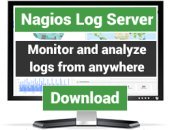Search Exchange
Search All Sites
Nagios Live Webinars
Let our experts show you how Nagios can help your organization.Login
Directory Tree
Telegram Notifications
Current Version
1.0
Last Release Date
2018-02-20
Compatible With
- Nagios 3.x
- Nagios 4.x
Owner
Website
Hits
36097
Files:
| File | Description |
|---|---|
| telegram-notify.zip | PHP script and manual |
Requirements:
-PHP 5.3 and above.
-Nagios 3 and above.
Instructions:
1. Telegram.
1.1. Find @BotFather in your telegram account.
1.2. Creating your own bot:
- Input command /newbot
- Define name for your bot. For example: Nagios-Notify
- Define username for your bot. Username must be with ending with "bot" or "_bot". For example: nagiosnotifybot
- If you done all right, you'll see congratulation message from BotFather. There is HTTP API key. Write down this information and bot's username as well.
1.3. Now you (and other users who need to telegram notifies) must add your bot to contact (find @nagiosnotifybot).
1.4. Find your chad_id value. Every user need to send message /my_id to in chat with your bot. After that open following URL:
https://api.telegram.org/bot83633434:kewkekekekdkkfiirrjririrjr/getUpdates
, where 83633434:kewkekekekdkkfiirrjririrjr -it's your HTTP API key (for example).
On this page you can find information, that see you bot. For example:
{"ok":true,"result":[{"update_id":135442367,"message":{"message_id":8,"from":{"id":370022700,"is_bot":false,"first_name":"myusername","username":"myusername","language_code":"ru"},"chat":{"id":370022700,"first_name":"myusername","username":"myusername","type":"private"},"date":1519148458,"text":"/my_id","entities":[{"offset":0,"length":6,"type":"bot_command"}]}}]}
, where 370022700 - it's your ID. Write down this information. You'll define this ID in your Nagios contact definitions.
2. PHP-script.
2.1. Download and unzip telegram-notify.zip in /usr/local/nagios/sbin folder. telegram-notify.zip contains:
- folder "telegram-notify";
- folder "log";
- php-script "telegram-bot.php";
- readme.txt;
- .htaccess file to protect writable log folder;
2.2. Give write permittions to "log" folder for nagios user and protect htaccess file.
chown nagios:nagios -R /usr/local/nagios/sbin/telegram-notify/log/
chmod 775 -R /usr/local/nagios/sbin/telegram-notify/log/
chown root:root /usr/local/nagios/sbin/telegram-notify/log/.htaccess
chmod 644 /usr/local/nagios/sbin/telegram-notify/log/.htaccess
2.3. Now you can send test message from command line to see if everything is ok:
- login as nagios user: su - nagios.
- run script (example): php /usr/local/nagios/sbin/telegram-notify/telegram-bot.php "370022700" "83633434:kewkekekekdkkfiirrjririrjr" 1 "Notify: NOTIFICATIONTYPE 0XzXZ0 Host: HOSTNAME 0XzXZ0 Service: SERVICEDESC 0XzXZ0 Date: SHORTDATETIME 0XzXZ0 Info: SERVICEOUTPUT"
, where
370022700 - telegram id of user who need to receive message;
83633434:kewkekekekdkkfiirrjririrjr - HTTP API key of your bot;
1 - mark. Script will send message if flag=1 only.
0XzXZ0 - fake linebreak character. I don't know why n doesn't work :(
If test was successful go to the last part - configuring nagios.
3. Nagios configuration.
3.1. Define command:
# Telegram notifies.
# 'notify-service-telegram' command definition
# Telegram-bot: @bsnagiosbot
# 0XzXZ0 - line break character.
# Example: php /usr/local/nagios/sbin/telegram-notify/telegram-bot.php "370022700" "83633434:kewkekekekdkkfiirrjririrjr" 1 "Notify: NOTIFICATIONTYPE 0XzXZ0 Host: HOSTNAME 0XzXZ0 Service: SERVICEDESC 0XzXZ0 Date: SHORTDATETIME 0XzXZ0 Info: SERVICEOUTPUT"
define command{
command_name notify-service-telegram
command_line /usr/bin/php /usr/local/nagios/sbin/telegram-notify/telegram-bot.php "$_CONTACTTELEGRAM$" "83633434:kewkekekekdkkfiirrjririrjr" $_SERVICESENDTELEGRAM$ "Notify: $NOTIFICATIONTYPE$ 0XzXZ0 Hsot: $HOSTNAME$ 0XzXZ0 Service: $SERVICEDESC$ 0XzXZ0 Date: $SHORTDATETIME$ 0XzXZ0 Info: $SERVICEOUTPUT$"
}
# 'notify-host-telegram' command definition
define command{
command_name notify-host-telegram
command_line /usr/bin/php /usr/local/nagios/sbin/telegram-notify/telegram-bot.php "$_CONTACTTELEGRAM" "83633434:kewkekekekdkkfiirrjririrjr" $_HOSTSENDTELEGRAM$ "Notify: $NOTIFICATIONTYPE$ 0XzXZ0 Host: $HOSTNAME$ 0XzXZ0 Date: $SHORTDATETIME$ 0XzXZ0 Info: $HOSTOUTPUT$"
}
3.2. Add notifying command to generic-contact template:
define contact{
name generic-contact
...
service_notification_commands notify-service-by-email-bs,notify-service-xml-sms,notify-service-skype,notify-service-telegram
host_notification_commands notify-host-by-email-bs,notify-host-xml-sms,notify-host-skype,notify-host-telegram
...
}
3.3. You can define _SENDTELEGRAM with value 1 to you host/services template OR create telegram-service and telegram-host templates which can be joined to your host/service. Variable _SENDTELEGRAM will be used as mark = 1 (see point 2.3). So only particular hosts/services will participate in telegram notifying.
define service{
name telegram-service
_SENDTELEGRAM 1;
register 0;
}
define service{
name telegram-host
_SENDTELEGRAM 1;
register 0;
}
3.4. Define contact. Here we specify variable _telegram.
define contact{
contact_name nagiosadmin
use generic-contact
...
_telegram 370022700
...
}
4. Test and apply configurations and check whether everything works properly. Enjoy!
-PHP 5.3 and above.
-Nagios 3 and above.
Instructions:
1. Telegram.
1.1. Find @BotFather in your telegram account.
1.2. Creating your own bot:
- Input command /newbot
- Define name for your bot. For example: Nagios-Notify
- Define username for your bot. Username must be with ending with "bot" or "_bot". For example: nagiosnotifybot
- If you done all right, you'll see congratulation message from BotFather. There is HTTP API key. Write down this information and bot's username as well.
1.3. Now you (and other users who need to telegram notifies) must add your bot to contact (find @nagiosnotifybot).
1.4. Find your chad_id value. Every user need to send message /my_id to in chat with your bot. After that open following URL:
https://api.telegram.org/bot83633434:kewkekekekdkkfiirrjririrjr/getUpdates
, where 83633434:kewkekekekdkkfiirrjririrjr -it's your HTTP API key (for example).
On this page you can find information, that see you bot. For example:
{"ok":true,"result":[{"update_id":135442367,"message":{"message_id":8,"from":{"id":370022700,"is_bot":false,"first_name":"myusername","username":"myusername","language_code":"ru"},"chat":{"id":370022700,"first_name":"myusername","username":"myusername","type":"private"},"date":1519148458,"text":"/my_id","entities":[{"offset":0,"length":6,"type":"bot_command"}]}}]}
, where 370022700 - it's your ID. Write down this information. You'll define this ID in your Nagios contact definitions.
2. PHP-script.
2.1. Download and unzip telegram-notify.zip in /usr/local/nagios/sbin folder. telegram-notify.zip contains:
- folder "telegram-notify";
- folder "log";
- php-script "telegram-bot.php";
- readme.txt;
- .htaccess file to protect writable log folder;
2.2. Give write permittions to "log" folder for nagios user and protect htaccess file.
chown nagios:nagios -R /usr/local/nagios/sbin/telegram-notify/log/
chmod 775 -R /usr/local/nagios/sbin/telegram-notify/log/
chown root:root /usr/local/nagios/sbin/telegram-notify/log/.htaccess
chmod 644 /usr/local/nagios/sbin/telegram-notify/log/.htaccess
2.3. Now you can send test message from command line to see if everything is ok:
- login as nagios user: su - nagios.
- run script (example): php /usr/local/nagios/sbin/telegram-notify/telegram-bot.php "370022700" "83633434:kewkekekekdkkfiirrjririrjr" 1 "Notify: NOTIFICATIONTYPE 0XzXZ0 Host: HOSTNAME 0XzXZ0 Service: SERVICEDESC 0XzXZ0 Date: SHORTDATETIME 0XzXZ0 Info: SERVICEOUTPUT"
, where
370022700 - telegram id of user who need to receive message;
83633434:kewkekekekdkkfiirrjririrjr - HTTP API key of your bot;
1 - mark. Script will send message if flag=1 only.
0XzXZ0 - fake linebreak character. I don't know why n doesn't work :(
If test was successful go to the last part - configuring nagios.
3. Nagios configuration.
3.1. Define command:
# Telegram notifies.
# 'notify-service-telegram' command definition
# Telegram-bot: @bsnagiosbot
# 0XzXZ0 - line break character.
# Example: php /usr/local/nagios/sbin/telegram-notify/telegram-bot.php "370022700" "83633434:kewkekekekdkkfiirrjririrjr" 1 "Notify: NOTIFICATIONTYPE 0XzXZ0 Host: HOSTNAME 0XzXZ0 Service: SERVICEDESC 0XzXZ0 Date: SHORTDATETIME 0XzXZ0 Info: SERVICEOUTPUT"
define command{
command_name notify-service-telegram
command_line /usr/bin/php /usr/local/nagios/sbin/telegram-notify/telegram-bot.php "$_CONTACTTELEGRAM$" "83633434:kewkekekekdkkfiirrjririrjr" $_SERVICESENDTELEGRAM$ "Notify: $NOTIFICATIONTYPE$ 0XzXZ0 Hsot: $HOSTNAME$ 0XzXZ0 Service: $SERVICEDESC$ 0XzXZ0 Date: $SHORTDATETIME$ 0XzXZ0 Info: $SERVICEOUTPUT$"
}
# 'notify-host-telegram' command definition
define command{
command_name notify-host-telegram
command_line /usr/bin/php /usr/local/nagios/sbin/telegram-notify/telegram-bot.php "$_CONTACTTELEGRAM" "83633434:kewkekekekdkkfiirrjririrjr" $_HOSTSENDTELEGRAM$ "Notify: $NOTIFICATIONTYPE$ 0XzXZ0 Host: $HOSTNAME$ 0XzXZ0 Date: $SHORTDATETIME$ 0XzXZ0 Info: $HOSTOUTPUT$"
}
3.2. Add notifying command to generic-contact template:
define contact{
name generic-contact
...
service_notification_commands notify-service-by-email-bs,notify-service-xml-sms,notify-service-skype,notify-service-telegram
host_notification_commands notify-host-by-email-bs,notify-host-xml-sms,notify-host-skype,notify-host-telegram
...
}
3.3. You can define _SENDTELEGRAM with value 1 to you host/services template OR create telegram-service and telegram-host templates which can be joined to your host/service. Variable _SENDTELEGRAM will be used as mark = 1 (see point 2.3). So only particular hosts/services will participate in telegram notifying.
define service{
name telegram-service
_SENDTELEGRAM 1;
register 0;
}
define service{
name telegram-host
_SENDTELEGRAM 1;
register 0;
}
3.4. Define contact. Here we specify variable _telegram.
define contact{
contact_name nagiosadmin
use generic-contact
...
_telegram 370022700
...
}
4. Test and apply configurations and check whether everything works properly. Enjoy!
Reviews (8)
byninwin, August 26, 2020
Hi All,
I have successfully followed the instructions till 3.1 but i am confused starting 3.2.
Can someone please guide on correct steps. I tried doing trail and error but its not working.
Any help is highly appreciated.
Regards
I have successfully followed the instructions till 3.1 but i am confused starting 3.2.
Can someone please guide on correct steps. I tried doing trail and error but its not working.
Any help is highly appreciated.
Regards
byR4P7H0R, June 11, 2020
0
bysdbhabal, January 30, 2020
How to specify multiple telegram chat id in contacts.cfg for single nagiosadmin contact ?
byshoshin1, January 26, 2019
1 of 1 people found this review helpful
As the other reviewers have said, you will spend some time getting this to work...because of all the errors and typos in the instructions.
Developer, PLEASE put this on github. I volunteer to rewrite the instructions as a README and fix the problems. This would be a 5-star rating except for all the time I had to spend figuring it out.
Developer, PLEASE put this on github. I volunteer to rewrite the instructions as a README and fix the problems. This would be a 5-star rating except for all the time I had to spend figuring it out.
bypelicanmedia, July 9, 2018
Hi,
Thanks for the scripts... but...
There needs to be a lot more clarification (and spell checking) as to what variables need to go where and what they mean (as one of the other reviews say also).
i.e. _telegram XXXXXXXXX
Where is this variable? As the reference to call it is "$_CONTACTTELEGRAM$"
i.e _SENDTELEGRAM 1
Where is this variable? As the reference to call it is $_HOSTSENDTELEGRAM$ and $_SERVICESENDTELEGRAM$ (NOT in " ").
Thanks
Thanks for the scripts... but...
There needs to be a lot more clarification (and spell checking) as to what variables need to go where and what they mean (as one of the other reviews say also).
i.e. _telegram XXXXXXXXX
Where is this variable? As the reference to call it is "$_CONTACTTELEGRAM$"
i.e _SENDTELEGRAM 1
Where is this variable? As the reference to call it is $_HOSTSENDTELEGRAM$ and $_SERVICESENDTELEGRAM$ (NOT in " ").
Thanks
byyogirenggana, May 15, 2018
Please help me, I still confuse for setting this point 3.3
3.3. You can define _SENDTELEGRAM with value 1 to you host/services template OR create telegram-service and telegram-host templates which can be joined to your host/service. Variable _SENDTELEGRAM will be used as mark = 1 (see point 2.3). So only particular hosts/services will participate in telegram notifying.
Thank's
3.3. You can define _SENDTELEGRAM with value 1 to you host/services template OR create telegram-service and telegram-host templates which can be joined to your host/service. Variable _SENDTELEGRAM will be used as mark = 1 (see point 2.3). So only particular hosts/services will participate in telegram notifying.
Thank's
bynovokuznezk, February 27, 2018
u have the same error on host line
this is the correct with hoststate and servicestate:
define command{
command_name notification-telegram-service
command_line /usr/bin/php /usr/local/nagios/sbin/telegram-notify/telegram-bot.php "$_CONTACTTELEGRAM$" "477401126:AAGJ6fKMHqbxwigmwgQ2QbPFZhg83N2AQHY" $_SERVICESENDTELEGRAM$ " Notify: $NOTIFICATIONTYPE$ 0XzXZ0 Host: $HOSTNAME$
}
#notification-telegram-host
define command{
command_name notification-telegram-host
command_line /usr/bin/php /usr/local/nagios/sbin/telegram-notify/telegram-bot.php "$_CONTACTTELEGRAM$" "477401126:AAGJ6fKMHqbxwigmwgQ2QbPFZhg83N2AQHY" $_HOSTSENDTELEGRAM$ " Notify: $NOTIFICATIONTYPE$ 0XzXZ0 Host: $HOSTNAME$ 0$
}
this is the correct with hoststate and servicestate:
define command{
command_name notification-telegram-service
command_line /usr/bin/php /usr/local/nagios/sbin/telegram-notify/telegram-bot.php "$_CONTACTTELEGRAM$" "477401126:AAGJ6fKMHqbxwigmwgQ2QbPFZhg83N2AQHY" $_SERVICESENDTELEGRAM$ " Notify: $NOTIFICATIONTYPE$ 0XzXZ0 Host: $HOSTNAME$
}
#notification-telegram-host
define command{
command_name notification-telegram-host
command_line /usr/bin/php /usr/local/nagios/sbin/telegram-notify/telegram-bot.php "$_CONTACTTELEGRAM$" "477401126:AAGJ6fKMHqbxwigmwgQ2QbPFZhg83N2AQHY" $_HOSTSENDTELEGRAM$ " Notify: $NOTIFICATIONTYPE$ 0XzXZ0 Host: $HOSTNAME$ 0$
}


 New Listings
New Listings


